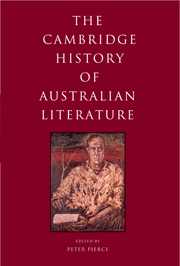Book contents
- Frontmatter
- Introduction
- FROM EUROPEAN IMAGININGS OF AUSTRALIA TO THE END OF THE COLONIAL PERIOD
- FROM THE LATE NINETEENTH CENTURY TO 1950
- TRAVERSES
- FROM 1950 TO NEARLY NOW
- 17 Publishing, patronage and cultural politics: Institutional changes in the field of Australian literature from 1950
- 18 Theatre from 1950
- 19 The short story since 1950
- 20 Scribbling on the fringes: Post-1950 Australian poetry
- 21 Groups and mavericks
- 22 The challenge of the novel: Australian fiction since 1950
- 23 The novel, the implicated reader and Australian literary cultures, 1950–2008
- 24 Nation, literature, location
- Select bibliography
- Index
- References
24 - Nation, literature, location
from FROM 1950 TO NEARLY NOW
Published online by Cambridge University Press: 28 May 2011
- Frontmatter
- Introduction
- FROM EUROPEAN IMAGININGS OF AUSTRALIA TO THE END OF THE COLONIAL PERIOD
- FROM THE LATE NINETEENTH CENTURY TO 1950
- TRAVERSES
- FROM 1950 TO NEARLY NOW
- 17 Publishing, patronage and cultural politics: Institutional changes in the field of Australian literature from 1950
- 18 Theatre from 1950
- 19 The short story since 1950
- 20 Scribbling on the fringes: Post-1950 Australian poetry
- 21 Groups and mavericks
- 22 The challenge of the novel: Australian fiction since 1950
- 23 The novel, the implicated reader and Australian literary cultures, 1950–2008
- 24 Nation, literature, location
- Select bibliography
- Index
- References
Summary
Until recently ‘Australian literature’ has been an imagined entity that belonged predominantly to the discourse of national culture and its institutions. The historiography of this institution, with its constant revisions and contradictions, is complex. But by far and away the strongest influence on its formation was the rage for nation that Europeans in Australia brought with them from the beginning. This will to nation, driven more than anything by an unassuageable hunger for identity in possession of the land, was political, social, psychological and mythic. It was also divided between an anxious sense of being displaced and inferior, and a confidence in being independent and distinctive. It imposed a precise and exclusive alignment of unitary ethnicity, national territory and literary tradition. Federation, as a political contract between regions with vast geographical differences, and with different histories of discovery and settlement, nevertheless imposed a continental sovereignty with determinate effects on the cultural field. The idea of an Australian ‘civilisation’ was understood as essentially bound to the establishment and legitimisation of a unisonant nation.
Thus the prefiguring of this nation-centred literature was read back into the intricacies of colonial writing. The flickers of its nativeness were discerned here and there for example, in William Charles Wentworth’s dream-vision of an Australian civilisation in his long poem of 1822, Australasia; in Charles Harpur’s topographic romanticism; in Catherine Helen Spence’s ‘unmistakeably (but not obtrusively) Australian novel’ (Clara Morison, 1854); and in Marcus Clarke’s assertions, in his preface to Adam Lindsay Gordon’s Sea Spray and Smoke Drift (1867), about the self-interpreting Australian bush and the beginnings of a national school of Australian poetry.
- Type
- Chapter
- Information
- The Cambridge History of Australian Literature , pp. 549 - 567Publisher: Cambridge University PressPrint publication year: 2009
References
- 6
- Cited by

